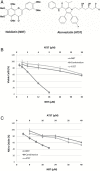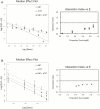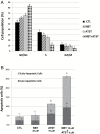Synergistic chemopreventive effects of nobiletin and atorvastatin on colon carcinogenesis
- PMID: 28207072
- PMCID: PMC6248647
- DOI: 10.1093/carcin/bgx018
Synergistic chemopreventive effects of nobiletin and atorvastatin on colon carcinogenesis
Abstract
Different cancer chemopreventive agents may act synergistically and their combination may produce enhanced protective effects against carcinogenesis than each individual agent alone. Herein, we investigated the chemopreventive effects of nobiletin (NBT, a citrus polymethoxyflavone) and atorvastatin (ATST, a lipid-lowering drug) in colon cancer cells/macrophages and an azoxymethane (AOM)-induced colon carcinogenesis rat model. The results demonstrated that co-treatments of NBT/ATST produced enhanced growth inhibitory and anti-inflammatory effects on the colon cancer cells and macrophages, respectively. Isobologram analysis confirmed that these interactions between NBT and ATST were synergistic. NBT/ATST co-treatment also synergistically induced extensive cell cycle arrest and apoptosis in colon cancer cells. Oral administration of NBT (0.1%, w/w in diet) or ATST (0.04%, w/w in diet) significantly decreased colonic tumor incidence and multiplicity in AOM-treated rats. Most importantly, co-treatment of NBT/ATST at their half doses (0.05% NBT + 0.02% ATST, w/w in diet) resulted in even stronger inhibitory effects on colonic tumor incidence and multiplicity than did NBT or ATST alone at higher doses. Statistical analysis confirmed that the enhanced chemopreventive activities against colon carcinogenesis in rats by the NBT/ATST combination were highly synergistic. Our results further demonstrated that NBT/ATST co-treatment profoundly modulated key cellular signaling regulators associated with inflammation, cell proliferation, cell cycle progression, apoptosis, angiogenesis and metastasis in the colon of AOM-treated rats. In conclusion, for the first time, our results demonstrated a strong synergy in inhibiting colon carcinogenesis produced by the co-treatment of NBT and ATST, which provided a scientific basis for using NBT in combination with ATST for colon cancer chemoprevention in humans.
© The Author 2017. Published by Oxford University Press. All rights reserved. For Permissions, please email: journals.permissions@oup.com.
Figures





Similar articles
-
A metabolite of nobiletin, 4'-demethylnobiletin and atorvastatin synergistically inhibits human colon cancer cell growth by inducing G0/G1 cell cycle arrest and apoptosis.Food Funct. 2018 Jan 24;9(1):87-95. doi: 10.1039/c7fo01155e. Food Funct. 2018. PMID: 29063088 Free PMC article.
-
Chemopreventive effects of nobiletin and its colonic metabolites on colon carcinogenesis.Mol Nutr Food Res. 2015 Dec;59(12):2383-94. doi: 10.1002/mnfr.201500378. Epub 2015 Oct 7. Mol Nutr Food Res. 2015. PMID: 26445322 Free PMC article.
-
Citrus nobiletin inhibits azoxymethane-induced large bowel carcinogenesis in rats.Biofactors. 2004;22(1-4):111-4. doi: 10.1002/biof.552210121. Biofactors. 2004. PMID: 15751122
-
Nobiletin and Derivatives: Functional Compounds from Citrus Fruit Peel for Colon Cancer Chemoprevention.Cancers (Basel). 2019 Jun 21;11(6):867. doi: 10.3390/cancers11060867. Cancers (Basel). 2019. PMID: 31234411 Free PMC article. Review.
-
Methoxylated flavones, a superior cancer chemopreventive flavonoid subclass?Semin Cancer Biol. 2007 Oct;17(5):354-62. doi: 10.1016/j.semcancer.2007.05.002. Epub 2007 May 13. Semin Cancer Biol. 2007. PMID: 17574860 Free PMC article. Review.
Cited by
-
Targeted Mevalonate Pathway and Autophagy in Antitumor Immunotherapy.Curr Cancer Drug Targets. 2024;24(9):890-909. doi: 10.2174/0115680096273730231206054104. Curr Cancer Drug Targets. 2024. PMID: 38275055 Review.
-
Repositioning of HMG-CoA Reductase Inhibitors as Adjuvants in the Modulation of Efflux Pump-Mediated Bacterial and Tumor Resistance.Antibiotics (Basel). 2023 Sep 20;12(9):1468. doi: 10.3390/antibiotics12091468. Antibiotics (Basel). 2023. PMID: 37760764 Free PMC article. Review.
-
Nobiletin, a citrus polymethoxyflavone, enhances the effects of bicalutamide on prostate cancer cells via down regulation of NF-κB, STAT3, and ERK activation.RSC Adv. 2020 Mar 10;10(17):10254-10262. doi: 10.1039/c9ra10020b. eCollection 2020 Mar 6. RSC Adv. 2020. PMID: 35498570 Free PMC article.
-
Synergistic Effect of Tangeretin and Atorvastatin for Colon Cancer Combination Therapy: Targeted Delivery of These Dual Drugs Using RGD Peptide Decorated Nanocarriers.Drug Des Devel Ther. 2020 Jul 29;14:3057-3068. doi: 10.2147/DDDT.S256636. eCollection 2020. Drug Des Devel Ther. 2020. PMID: 32801644 Free PMC article.
-
A metabolite of nobiletin, 4'-demethylnobiletin and atorvastatin synergistically inhibits human colon cancer cell growth by inducing G0/G1 cell cycle arrest and apoptosis.Food Funct. 2018 Jan 24;9(1):87-95. doi: 10.1039/c7fo01155e. Food Funct. 2018. PMID: 29063088 Free PMC article.
References
-
- Xiao H., et al. (2008) Combination regimen with statins and NSAIDs: a promising strategy for cancer chemoprevention. Int. J. Cancer, 123, 983–990. - PubMed
-
- DiMarco-Crook C., et al. (2015) Diet-based strategies for cancer chemoprevention: the role of combination regimens using dietary bioactive components. Annu. Rev. Food Sci. Technol., 6, 505–526. - PubMed
-
- Bose M., et al. (2007) Inhibition of tumorigenesis in ApcMin/+ mice by a combination of (-)-epigallocatechin-3-gallate and fish oil. J. Agric. Food Chem., 55, 7695–7700. - PubMed
-
- Xu G., et al. (2010) Combination of curcumin and green tea catechins prevents dimethylhydrazine-induced colon carcinogenesis. Food Chem. Toxicol., 48, 390–395. - PubMed
-
- Li S.M., et al. (2009) Chemistry and health effects of polymethoxyflavones and hydroxylated polymethoxyflavones. J. Funct. Foods, 1, 2–12.
MeSH terms
Substances
Grants and funding
LinkOut - more resources
Full Text Sources
Other Literature Sources

